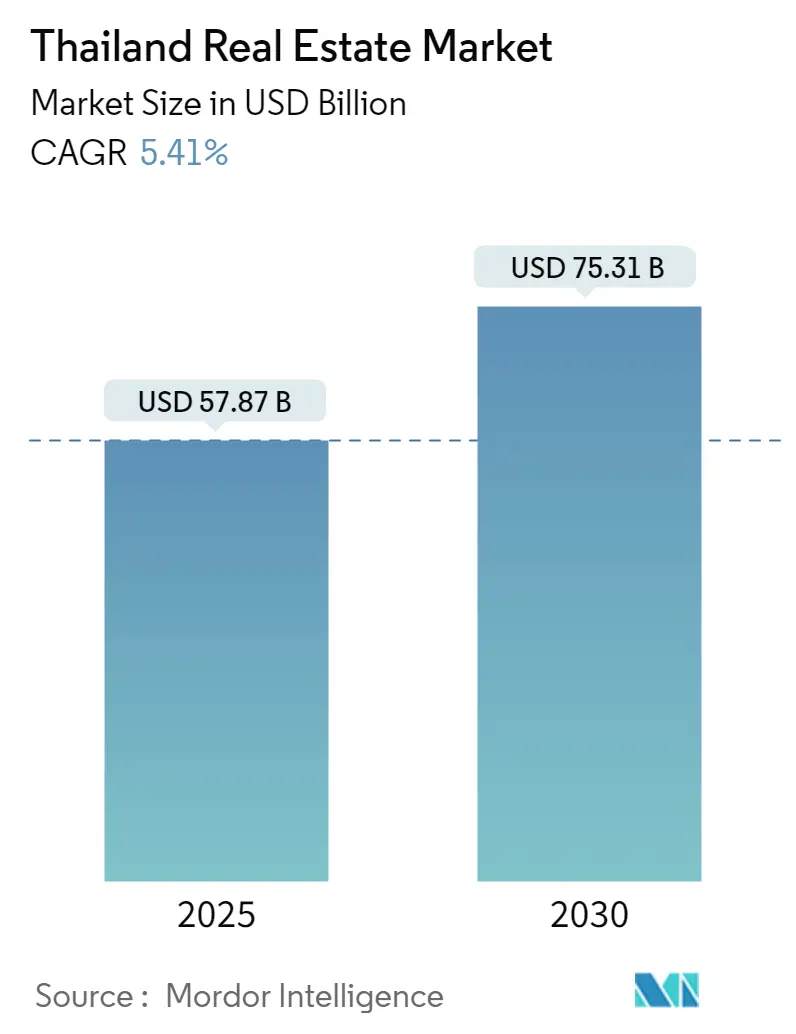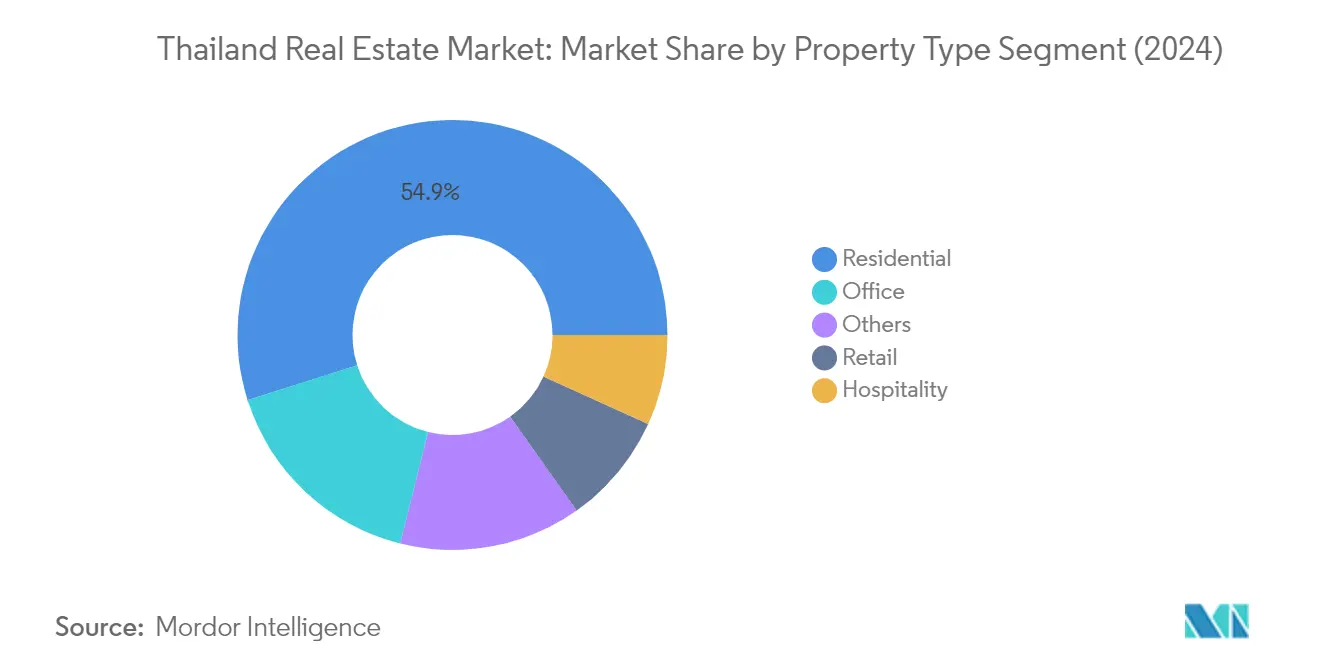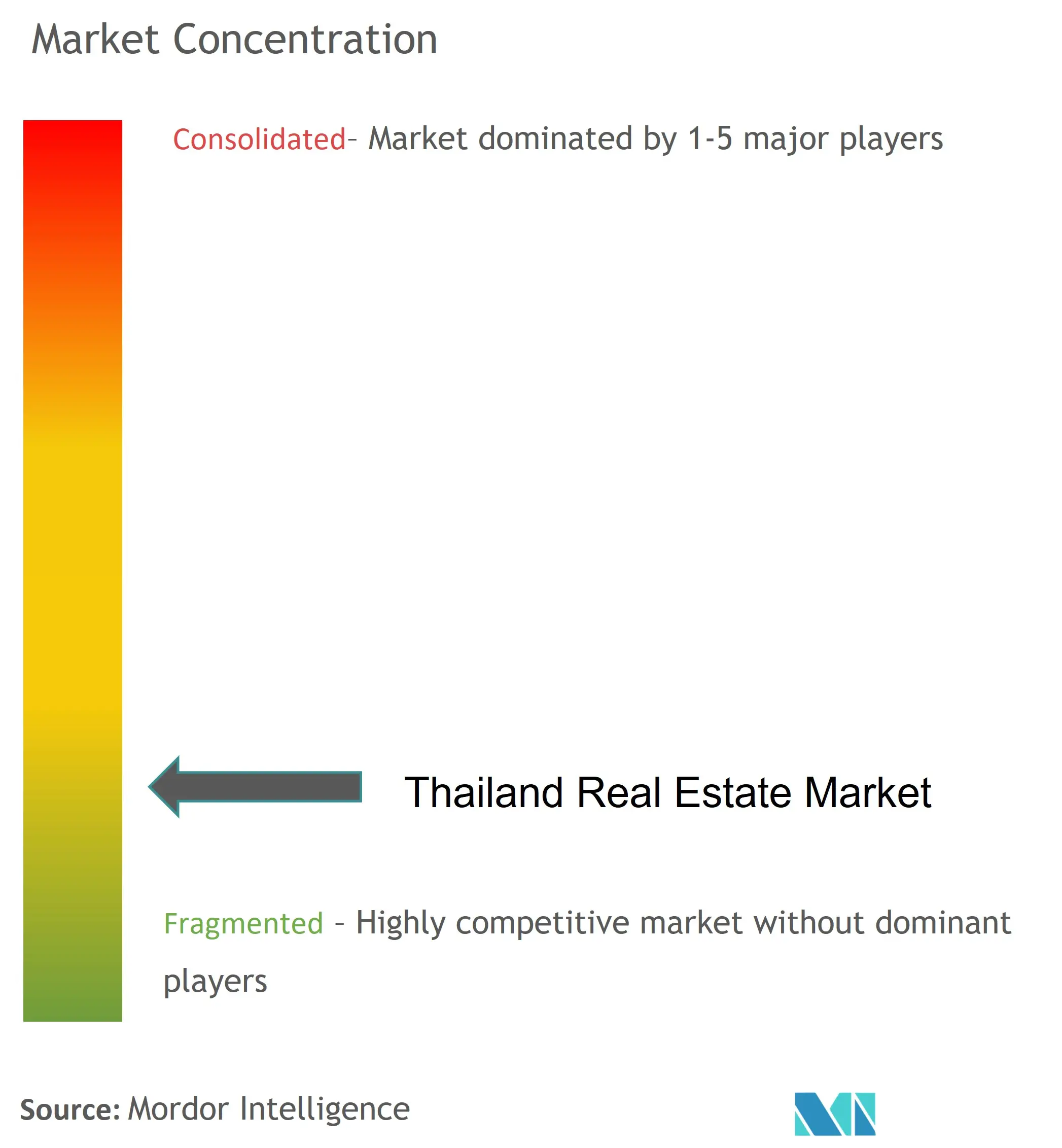
| Study Period | 2020 - 2030 |
| Base Year For Estimation | 2024 |
| Forecast Data Period | 2025 - 2030 |
| Market Size (2025) | USD 57.87 Billion |
| Market Size (2030) | USD 75.31 Billion |
| CAGR (2025 - 2030) | 5.41 % |
| Market Concentration | Low |
Major Players.webp)
*Disclaimer: Major Players sorted in no particular order |
Thailand Real Estate Market Analysis
The Thailand Real Estate Market size is estimated at USD 57.87 billion in 2025, and is expected to reach USD 75.31 billion by 2030, at a CAGR of 5.41% during the forecast period (2025-2030).
Thailand's real estate landscape is experiencing significant transformation driven by changing market dynamics and economic factors. The property market has shown resilience despite inflationary pressures and economic challenges, particularly in prime locations like central Bangkok and tourist destinations such as Koh Samui and Phuket. The government's proactive approach is evident in its implementation of supportive policies, including the second phase of the one-million-unit low-cost housing scheme with an estimated budget ranging from THB 30 billion to THB 50 billion. This initiative has been instrumental in maintaining market stability by offering lower interest rates and raising the ceiling price of housing units to THB 1.2 million, making property ownership more accessible to a broader segment of the population.
The commercial real estate sector has demonstrated notable evolution, particularly in the office space segment. In 2022, Bangkok's total office space supply reached a significant milestone of 5.56 million square meters, with the addition of a new building contributing 25,000 square meters of net leasable area. The market has witnessed a shift in tenant preferences towards more flexible and modern workspace solutions, with developers increasingly incorporating smart building technologies and sustainable features to meet evolving corporate requirements. This transformation is particularly evident in prime business districts, where premium-grade office spaces are being developed to cater to international standards and changing workplace dynamics.
The industrial real estate segment has emerged as a crucial growth driver, with significant developments particularly in the Eastern Economic Corridor (EEC). The sector has attracted substantial foreign investment, with four new industrial estate projects under development in the EEC, covering a total area of 5,981.83 rai. These developments are strategically positioned to capitalize on Thailand's growing role as a regional manufacturing and logistics hub, with modern facilities designed to accommodate advanced manufacturing technologies and automated systems. The projects are particularly focused on supporting target industries such as aviation, logistics, digital business, and biotechnology.
The retail real estate sector is undergoing substantial transformation, adapting to changing consumer behaviors and technological advancements. Major retail developers are implementing innovative concepts and digital integration in their properties, with several significant projects under development. Notable developments include the Terminal 21 Rama 3 project and various mixed-use developments that combine retail, office, and residential components. These projects reflect a broader trend toward creating integrated lifestyle destinations that cater to modern urban consumers' preferences for convenience and experience-based retail environments. The sector's evolution is further characterized by the integration of online and offline retail channels, with developers incorporating digital technologies and smart solutions to enhance the shopping experience.
Thailand Real Estate Market Trends
Growing Tourism Recovery and Foreign Investment
The robust recovery of Thailand's tourism sector is serving as a major catalyst for real estate market growth, particularly in prime tourist destinations like Phuket. The dramatic surge in international tourism arrivals, reaching 11.15 million visitors in 2022 and an impressive 6.5 million in just the first quarter of 2023, has sparked renewed interest in real estate investment from both domestic and international buyers. This revival is particularly evident in premium locations, where land prices have experienced substantial appreciation, with areas like Pa Sak-Kok Tanot Road in Thalang witnessing price increases of 20-30% and commanding premium rates of at least 14 million baht per rai.
The tourism sector's resurgence has specifically driven demand for luxury real estate accommodations and investment properties, with a notable trend toward high-end pool villas and premium residential developments. The Tourism Authority of Thailand's projected target of 25 million international visitors for 2023 signals strong potential for continued growth in real estate investment, particularly in tourist-centric locations. This optimistic outlook is further supported by total tourism receipts reaching 499 billion baht in Q1 2023, demonstrating the sector's significant contribution to driving real estate market dynamics and investment opportunities.
Infrastructure Development and Economic Growth
Thailand's strengthening economic fundamentals and ongoing infrastructure developments are playing a pivotal role in driving real estate market growth. The country's GDP growth acceleration from 1.5% in 2021 to 2.6% in 2022, coupled with the manufacturing sector's strong expansion as indicated by the S&P Global Thailand Manufacturing PMI, has created a favorable environment for property development. The expansion of mass transit systems, particularly in Bangkok's suburbs including the Yellow Line (Lat Phrao-Samrong) and Pink Line (Khae Rai-Min Buri), has significantly enhanced property values and development opportunities in previously underserved areas.
The strategic development of the Eastern Economic Corridor (EEC) across Chachoengsao, Chonburi, and Rayong provinces has emerged as a major driver for industrial and residential real estate growth. This is evidenced by the approval of new industrial estates like Smart Park Industrial Estate in Rayong and significant expansions of existing facilities such as Amata City Rayong Industrial Estate. These infrastructure developments are not only attracting substantial foreign direct investment but also creating new demand centers for residential and commercial property development in these emerging economic zones.
Evolving Consumer Preferences and Lifestyle Changes
The transformation in buyer preferences and lifestyle requirements is significantly influencing real estate market dynamics in Thailand. Premium locations are experiencing heightened demand for luxury real estate properties that offer a blend of lifestyle benefits and investment returns, particularly evident in the surge of interest for pool villas and high-end residential developments. This shift is notably visible in areas like Phuket, where the combination of natural beauty, developed infrastructure, and strong rental yield potential is attracting both domestic and international investors seeking lifestyle-oriented properties.
The market is witnessing a notable trend toward properties that offer modern amenities and sustainable features, with 93% of Thai consumers showing interest in sustainable living solutions. This includes specific preferences for houses with solar panel systems (62%), advanced cooling systems (58%), and pollution absorption functions (48%). The integration of smart home technology and the development of mixed-use residential projects reflect developers' strategic responses to these evolving consumer demands, ensuring long-term profitability while meeting the changing needs of modern homebuyers and investors. Additionally, the rise in real estate services and real estate listing platforms is facilitating access to these properties, further driving market engagement.
Segment Analysis: By Property Type
Residential Segment in Thailand Real Estate Market
The residential real estate segment continues to dominate the Thailand real estate market, holding approximately 55% market share in 2024. The segment's strong performance is driven by increasing urbanization and the development of new residential real estate projects across major cities. The Bangkok residential market has shown particular resilience, with significant development activities in both downtown and suburban areas. The market has been adapting to changing consumer preferences, with a notable shift towards sustainable living features such as solar panel systems, efficient cooling systems, and pollution absorption functions. Developers have also been focusing on integrating smart home technology and launching mixed-use residential property projects to ensure long-term profitability. The expansion of mass transit routes, particularly the BTS/MRT systems around Bangkok's suburbs, has been a key driver for property price appreciation in these areas.

Hospitality Segment in Thailand Real Estate Market
The hospitality segment is projected to be the fastest-growing sector in the Thailand real estate market from 2024 to 2029, with an expected growth rate of approximately 8%. This robust growth is primarily driven by Thailand's strong tourism recovery and strategic government initiatives to boost the sector. The segment is witnessing significant developments, with nearly 50 additional properties representing over 10,000 keys slated for operation. The market is experiencing a notable shift in tourist demographics, with increased visitors from Europe, North America, and the Middle East. Luxury and upscale hotels, particularly in prime tourist destinations like Phuket, continue to expand their presence. The sector's growth is further supported by the implementation of innovative hospitality concepts and the development of new tourist attractions across various regions of Thailand.
Remaining Segments in Thailand Real Estate Market
The office, retail real estate, and industrial/institutional segments collectively form a significant portion of Thailand's real estate market. The office segment has been evolving with the integration of flexible workspaces and modern amenities, particularly in CBD areas. The retail segment has been transforming through digital innovation and the development of mixed-use concepts, with shopping centers adapting to changing consumer behaviors. The industrial and institutional segment has been gaining momentum through the development of specialized facilities, particularly in the Eastern Economic Corridor (EEC), catering to various industries including e-commerce, logistics, and manufacturing. These segments continue to adapt to market demands through technological integration, sustainable development practices, and strategic location selection. Additionally, property management and property leasing are becoming increasingly important as these segments evolve, ensuring efficient operations and maximizing returns on rental property investments.
Thailand Real Estate Industry Overview
Top Companies in Thailand Real Estate Market
The Thailand real estate market is characterized by significant product innovation and strategic expansion initiatives by major developers. Companies are increasingly focusing on technological integration, including smart home features, digital payment solutions, and virtual property viewing capabilities to enhance customer experience. Operational agility is demonstrated through rapid adaptation to market changes, with developers shifting towards affordable housing segments and mixed-use developments. Strategic moves include partnerships with technology firms for digital transformation and cryptocurrency payment solutions, while geographical expansion is primarily concentrated along new mass transit routes and emerging suburban areas. Companies are also diversifying their portfolios by entering new segments such as wellness residences, senior housing, and industrial estates to capture evolving market opportunities.
Local Conglomerates Dominate Real Estate Development
The Thailand real estate market is predominantly controlled by established local conglomerates with diverse property portfolios spanning residential, commercial, and retail segments. Major developers like Central Group, The Mall Group, TCC Assets, and Singha Estate maintain significant market presence through their extensive land banks and integrated development capabilities. The market structure shows moderate consolidation, with large developers maintaining their stronghold in premium locations while smaller players focus on niche segments and specific geographical areas.
Market dynamics are shaped by strategic partnerships and joint ventures, particularly between local developers and international investors, especially in large-scale mixed-use projects. Recent market trends indicate increased collaboration between traditional real estate developers and technology companies, creating new business models in property development and management. The emergence of PropTech startups has introduced new competitive elements, though established developers maintain their market dominance through strong financial capabilities and land holdings.
Innovation and Adaptation Drive Future Success
Success in the Thailand real estate market increasingly depends on developers' ability to adapt to changing consumer preferences and technological advancement. Companies must focus on digital transformation, sustainable development practices, and innovative real estate technology solutions to maintain a competitive advantage. The integration of smart technologies, environmental considerations, and flexible space solutions has become crucial for market success, while the ability to offer diverse payment options and innovative financing solutions helps capture a broader customer base.
Future market leadership will require strong capabilities in managing end-user relationships through digital platforms and personalized real estate services. Developers need to address the growing demand for integrated living solutions while managing regulatory compliance, particularly in areas of foreign ownership and environmental standards. Success factors include the ability to navigate market cycles through diversified portfolios, strong balance sheets, and strategic land banking. Companies must also focus on building resilience against market disruptions through flexible development strategies and adaptable business models.
Thailand Real Estate Market Leaders
-
Pruska Real estate
-
LPN Development
-
Sansiri
-
Supalai
-
Ananda Development
- *Disclaimer: Major Players sorted in no particular order

Thailand Real Estate Market News
- January 2024: Sansiri Public Company Limited, a Thai real estate developer, designated Phuket as a strategic location to launch 16 new projects with a total value of THB 15 billion (USD 416.6 million) over the next five years. Sansiri is also expected to establish a new regional headquarters in Phuket to provide excellent after-sales services, reaffirming its commitment to serving both local and international customers.
- December 2023: Saudi Arabia and Thailand collaborated to enhance innovation and entrepreneurship, strengthening their bilateral ties. The bilateral trade relationship witnessed an uptick, with Riyadh hosting a four-day trade show in August featuring over 100 manufacturers and entrepreneurs from Thailand showcasing products across various sectors.
Thailand Real Estate Market Report - Table of Contents
1. INTRODUCTION
- 1.1 Study Assumptions
- 1.2 Scope of the Study
2. RESEARCH METHODOLOGY
3. EXECUTIVE SUMMARY
4. MARKET INSIGHTS
- 4.1 Overview of the Thailand Economy and Real Estate Market
- 4.2 Residential Real Estate Buying Trends - Socioeconomic and Demographic Insights
- 4.3 Government Initiatives and Regulatory Aspects for the Real Estate Sector
- 4.4 Insights on Rental Yields in the Residential Real Estate Segment
- 4.5 Insights Into Affordable Housing Support Provided By Government And Public-private Partnerships
- 4.6 Insights on Capital Market Penetration and REIT Presence in Real Estate
- 4.7 Focus On Technology Innovation, Startups And Proptech In Real Estate
- 4.8 Impact of COVID-19 on the Market
5. MARKET DYNAMICS
-
5.1 Drivers
- 5.1.1 The Rise in e-commerce and digitalization
-
5.2 Restraints
- 5.2.1 The Complexity of regulations and property ownership
-
5.3 Opportunities
- 5.3.1 Growing demand for eco friendly and sustainable properties
-
5.4 Industry Attractiveness - Porter's Five Forces Analysis
- 5.4.1 Bargaining Power of Suppliers
- 5.4.2 Bargaining Power of Consumers/Buyers
- 5.4.3 Threat of New Entrants
- 5.4.4 Threat of Substitute Products
- 5.4.5 Intensity of Competitive Rivalry
6. MARKET SEGMENTATION
-
6.1 By Type
- 6.1.1 Residential
- 6.1.2 Office
- 6.1.3 Retail
- 6.1.4 Hospitality
- 6.1.5 Industrial and Logistics
-
6.2 By Major Cities
- 6.2.1 Bangkok
- 6.2.2 Phuket
- 6.2.3 Pattaya
- 6.2.4 Chiang Mai
- 6.2.5 Hua Hin
- 6.2.6 Rest of Thailand
7. COMPETITIVE LANDSCAPE
-
7.1 Company Profiles
- 7.1.1 Market Concentration
- 7.1.1.1 Pruska Real estate
- 7.1.1.2 LPN Development
- 7.1.1.3 Sansiri
- 7.1.1.4 Supalai
- 7.1.1.5 Ananda Development
- 7.1.1.6 Central Pattana PLC
- 7.1.1.7 Pace Development Corporation PLC
- 7.1.1.8 Raimon Land
- 7.1.1.9 Origin Property
- 7.1.1.10 JCK International
- *List Not Exhaustive
- 7.2 Other Companies
8. MARKET OPPORTUNITIES AND FUTURE TRENDS
9. APPENDIX
Thailand Real Estate Industry Segmentation
Real estate is referred to as the land and any permanent, whether natural or artificial, structures or improvements related to the property, such as a house. A complete background analysis of the Thai real estate market, including the assessment of the economy and contribution of sectors in the economy, market overview, market size estimation for key segments, emerging trends in the market segments, market dynamics, geographical trends, and COVID-19 impact, is covered in the report.
The Thai real estate market is segmented by type (residential, office, retail, hospitality, and industrial) and by major cities (Bangkok, Phuket, Pattaya, Chiang Mai, Hua Hin, and Rest of Thailand). The report offers market sizes and forecasts for all the above segments in value terms (USD).
| By Type | Residential |
| Office | |
| Retail | |
| Hospitality | |
| Industrial and Logistics | |
| By Major Cities | Bangkok |
| Phuket | |
| Pattaya | |
| Chiang Mai | |
| Hua Hin | |
| Rest of Thailand |
Thailand Real Estate Market Research FAQs
How big is the Thailand Real Estate Market?
The Thailand Real Estate Market size is expected to reach USD 57.87 billion in 2025 and grow at a CAGR of 5.41% to reach USD 75.31 billion by 2030.
What is the current Thailand Real Estate Market size?
In 2025, the Thailand Real Estate Market size is expected to reach USD 57.87 billion.
Who are the key players in Thailand Real Estate Market?
Pruska Real estate, LPN Development, Sansiri, Supalai and Ananda Development are the major companies operating in the Thailand Real Estate Market.
What years does this Thailand Real Estate Market cover, and what was the market size in 2024?
In 2024, the Thailand Real Estate Market size was estimated at USD 54.74 billion. The report covers the Thailand Real Estate Market historical market size for years: 2020, 2021, 2022, 2023 and 2024. The report also forecasts the Thailand Real Estate Market size for years: 2025, 2026, 2027, 2028, 2029 and 2030.
Our Best Selling Reports
Thailand Real Estate Market Research
Mordor Intelligence provides a comprehensive analysis of the Thailand real estate market. We leverage extensive expertise in real estate services and industry consulting. Our research covers all major sectors, including residential real estate, commercial real estate, industrial real estate, and agricultural real estate. We also track emerging proptech solutions and real estate technology trends. The report offers detailed insights into property management practices and real estate investment opportunities. It explores the evolving landscape of office space and apartment developments, including both affordable housing initiatives and luxury real estate projects.
Stakeholders in property development, real estate brokerage, and property leasing sectors can access comprehensive market intelligence. Our report is available in an easy-to-download PDF format. The analysis covers crucial aspects of rental property dynamics, mortgage trends, and REIT performance indicators. Our research supports decision-making in land development, warehouse property investments, and retail real estate ventures. It also examines real estate construction activities and real estate listing platforms. The report's thorough examination of housing trends and property market dynamics enables industry professionals to navigate market challenges and identify growth opportunities effectively.




